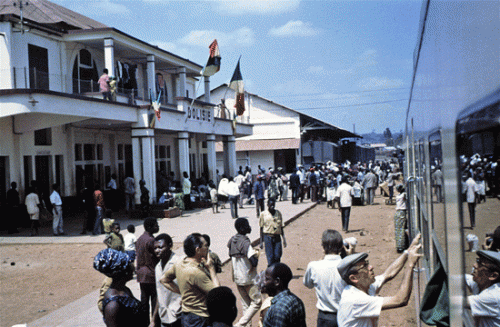The AIDS epidemic has spread with the development of transport, including rail, as here in the Republic of Congo in 1967. Credit: IRD / A. Dessier
A study published in Science magazine reveals for the first time where, when and how the world's AIDS pandemic originated. Thanks to a statistical analysis of all the genetic data available on the human immunodeficiency virus (HIV), an international research team has just confirmed that the scourge broke out in 1920 in Kinshasa, the capital of what is now the Democratic Republic of the Congo. By comparing this result with historical data, researchers explain how, from a single contamination by a chimpanzee, HIV spread to humans.
AIDS is one of the most devastating diseases in the history of humanity. Since its transmission to humans by great apes, the pathogen responsible, the human immunodeficiency virus (HIV) has infected 75 million people. However, thirty years after the discovery of its existence, little was known about the chain of events at the origin of the global pandemic. An international team, led by the universities of Oxford and Louvain in collaboration with IRD researchers, has just published a new study in Science magazine that reveals where the pandemic broke out and how it spread.
Epicentre of the disease discovered in Kinshasa
Thanks to genome sequencing of the virus and the latest phylogeographic techniques, researchers have recreated the epidemic's genetic history. Scientists had previously identified chimpanzees from South Cameroon as the source of AIDS. There have been several human contaminations by these great apes throughout history, but only one of these cases led to the spread of HIV to humans.
• Latest Medical Xpress updates on Facebook: https://www.facebook.com/medicalxpress
To determine where and when the epidemic originated, researchers compared the genetic diversity of the viruses collected in the countries of the Congo Basin, considered potential birthplaces. The result: the origin of the scourge was Kinshasa, the capital of what is now the Democratic Republic of the Congo, and dates back to 1920.
Emergence of a pandemic
Once the geographic origin of HIV was determined, scientists were able to link their genetic data on the virus' evolution with historical data, to determine the circumstances that enabled its outbreak in Kinshasa and its spread among human populations. Belgian colonial archives on the former Zaire reveal that at the beginning of the century a great deal of trade took place by river (ivory, rubber, etc.) between South-East Cameroon and Kinshasa. This could explain why the human epidemic broke out in the Congolese capital and not in Cameroon where the chimpanzees that contaminated humans are found.
Then between 1920 and 1950, urbanisation and the development of transport, particularly railways, made Kinshasa one of the most connected cities in Central Africa. At the end of the 1940s, over a million people passed through the city each year to reach the north or south of the country or travel to neighbouring countries. This unusual cocktail of factors, combined with the virus' genetic adaptability, led to its very rapid spread throughout the country (large like West Europe) as well as secondary outbreaks as far as South and East Africa. Later, after the 1960s, other social changes, such as the rise in prostitution and the use of non-sterile needles in public health initiatives, undoubtedly contributed to transforming small outbreaks of infection into a real pandemic.
More information: Bedford, M. Ward, A. Tatem, J. D. Sousa, N. Arinaminpathy, J. Pépin, D. Posada, Martine Peeters, O. Pybus, P. Lemey. "The early spread and epidemic ignition of HIV-1 in human populations," Science, 2014, Vol. 346 no. 6205 pp. 56-61. DOI: 10.1126/science.1256739
Keele et al." Chimpanzee reservoirs of pandemic and nonpandemic HIV-1." Science, 2006, 313 (5786), p. 523-526. ISSN 0036-8075 fdi:010035725
Journal information: Science
Provided by Institut de Recherche pour le Développement (IRD)





















